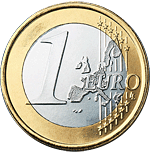 The bank is selling 1 € at auction. The minimum bid is 0.01 €.
The bank is selling 1 € at auction. The minimum bid is 0.01 €.
There is no minimum progress for bidders. So you are permitted to add 0.01 € as you bid.
Rule:
The last bidder (the winner) and the one before last each pay the amount of their last bid to the bank.
Examples:
1) The Euro sells for 0.40 €. The last bid before the end was 0.30 €. So the bank gets 0.70 € for the Euro. That is a loss of 0.30 €.
2) The Euro sells for 0.90 €. The last bid before was 0.85 €. So the bank gets 1.75 €. That is a profit of 0.75 €.
It seems that the bank has good chances of making a profit. The maximum profit possible for each auction is 99 cents (well, if bidders are extremely “unreasonable” – or if the Euro has a collector’s special value, there are, naturally, no upper limits).
But if the players are reasonable, all players will always contribute one additional cent. And the bank will then make a total profit of 99 Euros after 100 games.
Well, a nice game. But what do we learn from it?
Nothing! Or a lot? I do not know. Perhaps this is another nice mental game – but where is the meaning behind it?
RMD
(Translated by EG)
P.S.
🙂 This article is part of my series “grumbling about the game theory”.

